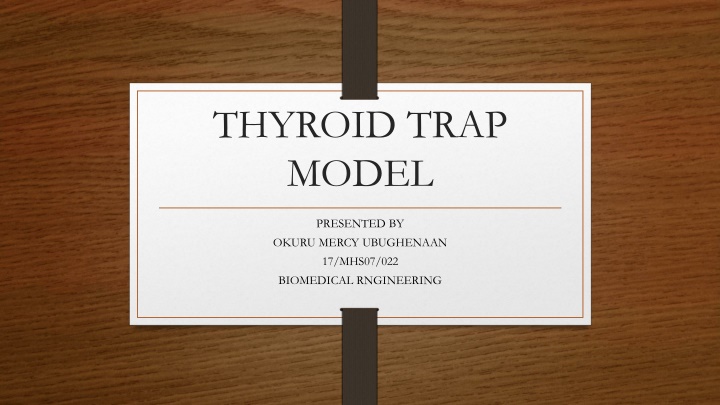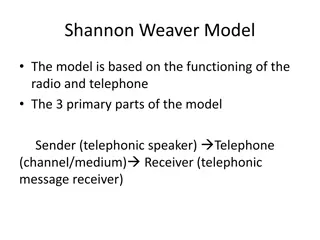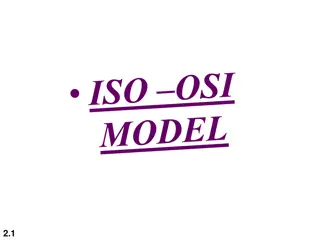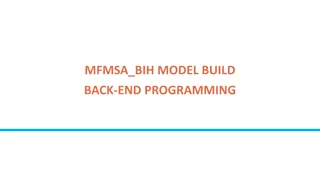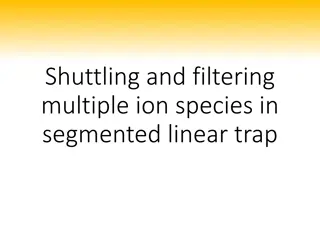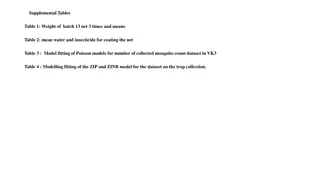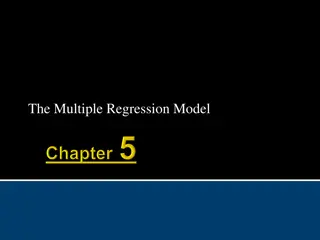Thyroid Trap Model
Utilizing a compartmental model to analyze thyroidal pertechnetate kinetics, this study explores the impact of competitive inhibition on the thyroid trap. By incorporating additional compartments and studying plasma differential, researchers shed light on the dynamics of thyroidal uptake and propose hypotheses on the underlying processes. The experimental sessions conducted with volunteer college students offer insights into thyroid function and model development in biomedical engineering.
Download Presentation

Please find below an Image/Link to download the presentation.
The content on the website is provided AS IS for your information and personal use only. It may not be sold, licensed, or shared on other websites without obtaining consent from the author.If you encounter any issues during the download, it is possible that the publisher has removed the file from their server.
You are allowed to download the files provided on this website for personal or commercial use, subject to the condition that they are used lawfully. All files are the property of their respective owners.
The content on the website is provided AS IS for your information and personal use only. It may not be sold, licensed, or shared on other websites without obtaining consent from the author.
E N D
Presentation Transcript
THYROID TRAP MODEL PRESENTED BY OKURU MERCY UBUGHENAAN 17/MHS07/022 BIOMEDICAL RNGINEERING
CASE STUDY Subjects were paid volunteer college students, at least 21 years old. Three were men and three were women. Each subject underwent six experimental sessions, identical except for NaI and KCIO4 medication. We will discuss the application of the data from this experiment to model development, particularly with regard to the impact of competitive inhibition of the trap both before and during a session.
THYROID TRAP In order to utilize the known physiology of the thyroid trap in analyzing thyroidal pertechnetate (an oxoanion with the chemical formula TcO-4) kinetics, a compartmental model (Fig. 2) was developed, in which plasma pertechnetate is the input function into the trap. Because we made no attempt to measure plasma volume, the volume of the plasma compartment, V1, was arbitrarily defined as 1 ml. Hence, the rate constant from plasma into the thyroid, lambda21, is equivalent to plasma clearance.
THYROID TRAP CONTD Originally, the trap was represented by a single compartment C3 but this model was inadequate to fit the data for the research. An additional compartment, C2, was added representing a very rapidly exchanging compartment together with any plasma contained in the thyroid that is not accounted for by the neck background (the plasma differential ). Addition of this compartment improved the least squares fit of the data, as well as improving the visual fit.
Initially, compartment C2 was thought to be just plasma, and was represented, together with neck background, as a non thyroidal component of the total gross thyroid uptake. However, blocking of thyroidal uptake by pretreatment completely obliterated C2 as well as C3 in every case. In fact, in five of the six test subjects, V2 was negative, suggesting a small negative plasma differential , or overcorrection of plasma activity by neck background. These studies were considered to show that entry into C2 is a process that is subject to competitive inhibition.
HYPOTHESIS The working hypothesis is that C2 represents activity in the thyroidal follicular cell, and that C3 represents pertechnetate contained within the follicular lumen. Lambda21, the clearance or rate constant for the transport from plasma into C2, is identified as the probable site of competitive inhibition.
CONCLUSION In its final form, the working version of the model solves for V2 (volume of compartment 2), for lambda23 (the exit from C3) , and for the plasma clearance into C3, which is the product of V2 and lambda32. In order to derive lambda21 and lamda12, we assumed that a molecule, once having entered the follicular cell, has an equal chance of leaving through the apical or the basal cell membrane. By this assumption, lambda12 = lamda32. It also indicates that lambda21 =(V2)lambda32.
BIOMEDICAL CONTEXT This model is being applied to analysis of data from a variety of clinical and experimental situations. Based on this, it is also important to state that this model is used solely for analysis. The input variable for this model is plasma pertechnetate.
REFERENCES Kinetics of the Human Thyroid Trap: A Compartmental Model Marguerite T. Hays Veterans Administration Hospitals, Buffalo, New York, Washington, D.C., and Veterans Administration Central Office, Washington, D.C. Google scholar
